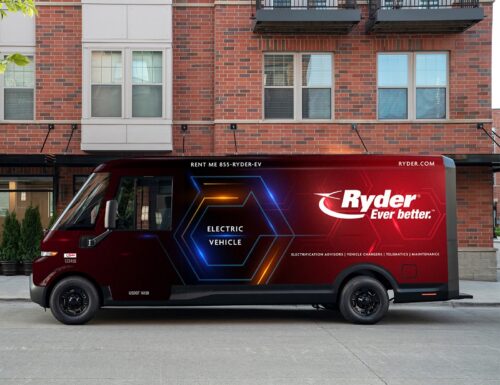Green Logistics: Meaning, Tips, and Challenges

The transportation industry stands at a pivotal crossroads. With increasing concerns about environmental issues, green logistics emerged as a potential solution to tackle rising carbon emissions, waste management, and other challenges associated with conventional logistics operations.
This article offers insights into green logistics and its importance in fostering sustainable solutions in the industry and how it impacts the supply chain. Understand how companies, influenced by customer demand and eco-conscious values, prioritize sustainability for a brighter, cleaner future.
How Green Logistics Works in the Supply Chain
Green logistics involves implementing sustainable practices in logistics operations to reduce the environmental impact. By incorporating green logistics strategies, businesses can contribute to environmental sustainability and find ways to save money and boost their brand image.
These strategies focus on reducing waste, fuel consumption, greenhouse gas emissions, and energy consumption while ensuring efficient supply chain management. A shining example is UPS, which adopted route optimization for its delivery vehicles, resulting in fewer shipments and lower fuel consumption. Such successes show how a shift toward sustainable logistics benefits the planet and the company’s bottom line.
As a logistics company explores sustainable options, harnessing new technological advances plays a significant role. Integrating AI technology offers predictive analytics that utilizes the optimization of supply routes and inventory management.
Similarly, blockchain technology allows transparent and efficient supply chain tracking and builds confidence in stakeholders by maintaining environmentally friendly practices. Thus, leveraging these technologies expedites the shift toward more sustainable logistics operations.
Regenerating a Supply Chain by Reducing Greenhouse Gas Emissions
The global concern about rising greenhouse gas emissions pushed logistics providers to consider eco-friendly practices.
Challenges: High upfront investment in sustainable materials and alternative fuels, resistance to change within traditional supply chains, and the pressure of competitive advantage in logistics processes can create barriers.
Benefits: Reduced carbon dioxide emissions, improved brand reputation, and potential cost savings in the long run.
Deterrent or Duty?: While some see it as a hefty investment, the long-term advantages and the growing customer demand for environmentally conscious businesses make it an essential duty.
The emergence of digital platforms and software applications aids in tracking a company’s carbon footprint in real time and offers invaluable insights into logistics processes. Such tools enable businesses to develop action plans, target specific areas, and track the progress of their carbon footprint.
Importance of Collecting CO2 Data
Accurate collection and analysis of CO2 data is paramount in the logistics industry.
Challenges: The accuracy of tools to measure carbon footprint and other metrics across the industry and costs associated with data collection systems.
Benefits: Understanding a company’s environmental footprint allows for targeted sustainability efforts and showcases transparency in the supply chain to customers.
Deterrent or Duty?: With increasing regulations and growing awareness of climate change, CO2 data collection is becoming a requisite for businesses.
With the adoption of IoT (Internet of Things) devices, companies have an unprecedented level of granular data. Combined with analytics, this data provides actionable insights for better fleet management, load optimization, and route planning, ensuring the least environmental impact possible.
Carbon Offsetting Tactics Make a Difference
Companies are considering carbon offsetting as essential to their green logistics strategy.
Challenges: Identifying genuine offset projects and understanding the real-world impact of these projects and the potential cost of investing in these initiatives.
Benefits: Directly contributes to reducing the impact of carbon emissions on the environment and enhances brand image.
Deterrent or Duty?: As the detrimental effects of carbon emissions become more evident, carbon offsetting transforms from a good-to-have initiative to a necessary business practice.
Collaborations with environmental NGOs and agencies can offer insights and support for companies venturing into carbon offsetting. Such collaborations also provide a credible front to the company’s efforts, as these agencies are often recognized for their work in environmental conservation.
Alternate Fuel Choices and Environmental Impact
Alternative fuels, such as biofuels and hydrogen, present opportunities for the logistics sector.
Challenges: Infrastructure for alternative fuel vehicles, initial investment costs, and the time to see a return on investment.
Benefits: Significant reductions in greenhouse gas emissions, lower transportation costs, and a shift away from reliance on fossil fuels.
Deterrent or Duty?: As fossil fuel reserves deplete and their impact on the environment becomes clearer, turning to alternative fuels isn’t just an option but a pressing need.
In the realm of biofuels, advancements in algae-based fuels present exciting possibilities.
Algae-derived biofuels are more sustainable, don’t compete with food sources, and can be grown in diverse environments. Thus, their integration into the logistics sector could be transformative.
Electric Delivery Methods

The advent of electric vehicles (EVs) is reshaping the logistics industry.
Challenges: High initial costs, limited battery range, and a lack of charging infrastructure affect the supply chain.
Benefits: Drastic reduction in carbon emissions, energy savings, and reduced noise pollution.
Deterrent or Duty?: The push towards EVs is undeniable. With the dual benefits of environmental conservation and potential long-term savings, electric delivery methods are replacing the industry standard.
Innovation in battery technology, such as solid-state batteries, promises longer battery life and faster charging times. Coupled with solar charging stations and renewable energy sources, the future of electric transportation in the logistics sector seems brighter than ever.
Green Logistics and Reducing Carbon Footprints
In an era dominated by global discussions around climate change, the shipping industry is under intense scrutiny. Transport vessels emit significant greenhouse gasses and impact our environment. Consequently, the ripple effect of this pollution is extensive.
It negatively affects the environment and a company’s brand image, customer relationships, and operational costs.
Adopting green logistics becomes an environmental imperative and a strategic move for businesses seeking long-term viability and growth.
Create Customer Awareness
Engaging customers in the sustainability journey is paramount. By raising awareness about a company’s eco-logistics efforts, businesses can fortify trust and loyalty among existing customers while attracting a new, environmentally-conscious clientele. Transparent communication about sustainability can reinvigorate old relations and set the foundation for future partnerships.
Leveraging digital platforms and social media can amplify the message. Companies can foster a community of eco-conscious consumers and stakeholders by sharing behind-the-scenes glimpses of sustainable initiatives, stories of successful green transitions, or even educational content about the environment.
Regenerating Route Maps and Capturing Energy Savings
Switching to efficient route maps and delivery methods sets companies on a new growth trajectory. Through optimized route planning, companies minimize fuel consumption and thereby reduce carbon emissions. Furthermore, by exploring alternative energy-saving delivery methods, businesses can diminish their environmental footprint while capturing significant energy and cost savings.
Reduce, Recycle, and Promote Green Logistics
Embracing the reduction, recycling, and reuse principles can profoundly transform logistics practices. By reducing waste, especially in packaging and recycling materials, companies significantly diminish their environmental footprint. Promoting alternative delivery methods and integrating them into the core logistics network is the future of sustainable and eco-friendly operations.
Challenges Facing Green Logistics Industry
Transitioning to green logistics has its challenges. Companies depend on high upfront investments, struggle with resistance within their operations, and battle a labyrinth of regulations and standards that are challenging to navigate.
Cost of Going Green
Embracing sustainable practices demands a generous upfront investment. From overhauling fleets with eco-friendly vehicles to implementing sophisticated tracking systems for carbon emissions, the initial costs are daunting and make businesses hesitant to convert to green solutions.
Partnering With Green Solution Companies
Building partnerships with green logistics providers can be a catalyst for sustainable transformation. These collaborations offer access to cutting-edge technologies, shared expertise, and best practices. However, fostering such relationships requires trustworthy alignment regarding values, goals, and long-term vision.
Benefits of Switching
Opting for green logistics solutions transcends environmental benefits. In the long run, companies will harvest significant cost savings through energy efficiency and waste reduction. Additionally, adopting eco-friendly practices enhances brand reputation within a growing segment of environmentally-conscious consumers and positions the business as a forward-thinking industry leader.
Top Tips for Going to Green Logistics
While the transition to green logistics encompasses many challenges, exciting, innovative tools and strategies continually emerge to facilitate this shift. By harnessing these resources, companies can mitigate environmental impact while optimizing their operations.
Alternative Green Shipping Materials
Sustainable packaging materials like biodegradable plastics or reused cardboard significantly reduce waste. Websites like the Sustainable Packaging Coalition offer insights and guidelines on choosing eco-friendly alternatives for shipping needs.
Impact of Shipping Full-Loads and Space-Saving Tips
Maximizing load capacity reduces the trip cost by reducing fuel consumption and emissions. Resources like the National Industrial Transportation League provide guidelines on efficient load planning and space optimization.
Reducing Customer Returns Effectively
Implementing robust quality checks and accurate product descriptions can minimize return rates. Reverse logistics strategies and best practices reduce and manage returns sustainably.
Strategies for No-Fail Deliveries
Leveraging technology for real-time tracking, route optimization, and predictive analytics can ensure timely and accurate deliveries. Many organizations offer initiative green logistics tools and strategies to enhance delivery accuracy and efficiency.
Re-Thinking Carbon Emissions
Considering carbon offset programs or investing in alternative fuel vehicles plays a prominent role in diminishing carbon footprints. The Carbon Fund is an excellent resource for companies seeking to offset emissions and contribute to global sustainability projects.
Management Role in Green Logistics
Leadership’s commitment is pivotal for successful implementation. By setting clear sustainability goals, managers can drive organizational change. The Environmental Leader offers case studies and insights on how top executives can champion green initiatives in the logistics sector.
Why Green Logistics Companies Matter
The rise of green logistics companies symbolizes a revolutionary shift in the logistics industry, emphasizing sustainability and eco-friendly practices. Eco-conscious companies like DHL, with its GoGreen program, and UPS, with its alternative fuel fleet, project the industry’s evolution towards reducing carbon emissions and championing environmental stewardship.
FAQs
Diving into some of the commonly asked questions about green logistics.
What is meant by green logistics?
Green logistics refers to optimizing logistics and supply chain operations in an eco-friendly manner, minimizing environmental impact.
What are examples of green logistics?
Examples include using electric delivery vehicles, optimizing routes to save fuel, and utilizing biodegradable packaging materials.
Is Green Logistics a real company?
No, Green Logistics isn’t a specific company. It’s a term referring to sustainable and eco-friendly logistics practices.
Key Takeaways on Implementing Green Logistics
Embracing green logistics and other efficient logistics processes isn’t just a trend; it’s necessary for the environment and business longevity.
Implementing green logistics strategies allows companies to reduce their carbon footprint, optimize operations, and resonate with environmentally conscious consumers. As the logistics sector continues to evolve, prioritizing sustainability will be paramount.
